- Large Buildings
- Posted
In Defence of Height

It's easy to knock tall buildings. They consume a lot of power, they block light and they seem to represent a form of progress that has gone out of fashion in recent years.
It's hardly surprising that this should be the case. With increasing concerns about energy use and climate change dominating the political agenda these energy hungry buildings have come to represent the apex of unsustainable design. The Guardian's design editor Jonathan Glancey took up the baton of criticising tall building in a recent article 'Skyscrapers are costing the Earth'.
Glancey acknowledges the case for high-rise design in areas where land is at a premium but goes on to say: "It can be argued that the taller a building is, the greater is its hunger for lifts, air-conditioning, power and water. As it rises ever higher, so the amount of usable floor space diminishes. Towers are, very often, wasteful luxuries, like whirlpool baths or 4WD town cars decked out with all the chic accoutrements and electronic gadgets of limousines."
Notice how he segues effortlessly from an arguably justifiable environmental criticism into a simple form of snobbery: you like tall buildings? How gauche.

KenYeang's Canning Town Tower
How did the primary architectural form of the last century suddenly become the design equivalent of fake tan and bling-bling? Moreover, exactly what is a 'wasteful luxury', and who gets to decide these things? Glancey's criticisms smack of a very post-modern form of hair-shirt puritanism that middle-class liberals have pioneered over the last decade or so: they recycle all of their used rocket leaves and are damn well going to make everyone else suffer too.
It's of little consequence really, though. There are valid criticisms to be made of skyscrapers and the form is not going to go away. Pragmatism dictates that architects and engineers must address sustainability concerns with the form because they are going to become an increasingly common part of the built environment for two reasons:
Firstly, it is the nature of society that related businesses often cluster together in relatively small areas.
Secondly, urban sprawl is now considered a primary issue in planning. The European Environment Agency (EEA) cited Dublin as a 'worst-case scenario' of urban planning so that newer EU member states might avoid making the same mistakes. The key lesson will be to build up, not out.
It's something of a conceit – or at least a stretch of imagination – to describe any Irish building as a skyscraper. Even the nation's tallest building, Cork County Hall, at 67m (219 ft.) is more of a sky-worrier than a skyscraper per se. Nevertheless, it has to be asked: had the skyscraper not been anathema in 'Holy Ireland' would we now be faced with the twin problems of sprawl and traffic congestion in our major cities? When allied with an effective public transport network, high density building could significantly ease the pressure on the roads, and thus the environment.
Given the noted Irish preference for houses over apartments it is unlikely that high-density living will be on the agenda any time soon – the memories of overcrowded tenement living are simply too fresh and too strong, not to mention the perceived social problems in Irish inner cities – but this is an irrelevance when it comes to developing suitable commercial buildings in city centres.

Singapore National Library
Demonising buildings
It is certainly true that we have a love-hate relationship with the skyscraper. On the one hand, the skyscraper represents the machine age and thus humanity's (still pending) liberation from back-breaking and pointless toil. However, it is just this that forms part of the problem. Progress has gone out of fashion and the skyscraper's now inverted symbolic power seems to have taken on more value than the practical benefits of building skyward.
The linen mill or smokestack-adorned factory seems distant and virtually irrelevant to Western eyes, even as symbols. The skyscraper, however, remains emblematic of capitalism in both its Fordist and post-Fordist modes. As a result, the skyscraper is viewed as the pinnacle of human alienation rather than liberation through technology.
Trenchant critiques of the social and economic organisation that leads to alienation are rather harder to make than shouting 'boo' at something we don't like. The manifest failure of planned economies to bring either wealth of freedom has left even capitalism's staunchest critics with no realistic alternative. As a result, those with a bone to pick about equality have increasingly retreated into attacking the symbols and symptoms of how we organise society instead of the root cause of any malaise.
Capitalists are routinely excoriated for the damage they do to the environment (though rarely, if ever, the damage they do to workers: the liberal love affair with union busting Ben and Jerry's ice cream being a prime example) but the very same putative and armchair-bound radicals offer no alternative vision of how society should be organised and often seem all too willing to fund capitalism through the ownership of shares, otherwise known as private pensions funds.
In today's era of hypocritical political discourse the skyscraper is viewed as a symbol of excess, something to be ashamed of rather than a feat of engineering to be marvelled at. As a result of its close association with multinational capital, surely the bogeyman of contemporary politics, the Diplock court of professional activist opinion has found the skyscraper guilty of crimes against humanity (or 'Gaia', in the extremist version) and it often seems that no amount of designing strategies for sustainability is going to sate some critics.

Fox and Fowle's 4 Times Square
The future yesterday
In attempting to understand how the skyscraper sits in contemporary culture the architectural response to the terrorist attacks on what was probably the world's most well-known set of skyscrapers, the World Trade Center, is instructive.
Plans are well underway to replace Minoru Yamasaki's modernist-inspired twin towers – but with what?
The first reaction, directly after the attacks was to leave the site as a public memorial. This was quickly followed by the need to rebuild. Typical American bullishness could be seen in Donald Trump's (unsolicited) plans for 'Twin Towers II', a design which would have seen aesthetically identical buildings replace the originals but with a symbolic extra storey.
In actuality, the new building is being designed by the rather conservative David Childs who was given the job after the site's owners effectively sacked Daniel Libeskind, winner of the open competition to design the successor structure.
The structure, Freedom Tower, will be a symbolic 1776 ft. tall, commemorating the American Revolution. Clearly this is going to be one skyscraper that is even more openly political than most.
The reality was there was never even the slightest possibility of the World Trade Centre being replaced by anything other than a similarly huge structure. Land values on Manhattan island are simply too high for low-rise building – something that should, but doesn't, ring a bell with the Irish public.
Internationally, though, things do seem to be changing. Some architects and engineers have busied themselves rethinking the skyscraper. At its heart lies the idea that, were it not for issues of embodied energy and energy use in the building, ultra high-rise would be an excellent vehicle for sustainable architecture.
The Condé Nast building at Four Times Square in New York, designed by Fox and Fowle (now Cook + Fox), for example, uses environmentally-sound gas-fired absorption chillers and a high-performance insulating and shading curtain wall to ensure that the building does not need to be heated or cooled for the majority of the year. Additionally, the bulk of office furniture is made of biodegradable materials and recycling chutes proliferate throughout.
In Paris, meanwhile, plans are underway for a new skyscraper in the outlying La Défense district, the first such new building in many years. Designed by Thom Mayne of Los Angeles-based practice Morphosis, the 300 metre (990 ft.) building, nicknamed the Lighthouse, will cost €900 million and is due to be completed in 2012.
This despite what the newspaper Le Monde warned of as a "hatred for concrete" and fear of high buildings common among Parisians still traumatised by the 210 metre-tall Tour Montparnasse.
Key to assuaging Parisian fears about skyscraper is the building's environmental credentials. The tower is to be topped with a roof level wind farm which will provide electricity to the fans in the building’s natural ventilation system. Moreover, the building's form and the orientation will respond to the sun's path. The south facade’s curvilinear double skin is designed to minimise heat gain while the flat, clear-glazed north facade maximises natural daylight all year round.
New York, however, is not resting on its laurels. Construction is already underway on the Bank of America Tower, located at One Bryant Park in Manhattan, a building that promises to be one of the most environmentally friendly tall buildings in the United States to date.
In fact, the building's designers, Cook + Fox Architects, intend to build what it calls "[The] world's most environmentally responsible high-rise office building, focusing on sustainable sites, water efficiency, indoor environmental quality, and energy and atmosphere."
Contributing to this will be a wind turbine, translucent floor-to-ceiling insulating glass to contain heat and maximise natural daylight and low energy light-emitting diode (LED) lights that automatically dim during the daytime. The aim is also to reduce potable water consumption by 50 per cent and make no storm water contribution to the city's wastewater system
Attaining LEED Platinum, a key intention of the designers, will mean that the Bank of America Tower has reached the highest standard possible in the US Green Building Council’s LEED rating system which evaluates a building based on site issues, water efficiency, energy and atmosphere, materials and resources, indoor environmental quality and innovative design.
Notably, One Bryant Park will be the first high-rise office building in the US to attain this level of certification.
With designs like this on the cards we could be heading for a renaissance in skyscraper design, one in which ultra high-rise buildings become symbols of sound environmental practice, rather than voracious consumers of energy.
- Articles
- Large Buildings
- In Defence of Height
- skyskraper
- tall building
- unsustainable
- urban sprawl
- freedom tower
- Condé Nast
- Bank of America
Related items
-
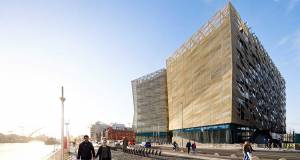 Ireland's new central bank hits nZEB & BREEAM outstanding eco rating
Ireland's new central bank hits nZEB & BREEAM outstanding eco rating -
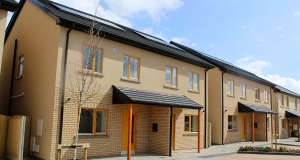 Ground-breaking housing scheme captures one developer’s journey to passive
Ground-breaking housing scheme captures one developer’s journey to passive -
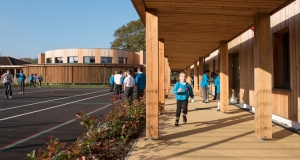 Welsh school fuses passive & eco material innovation
Welsh school fuses passive & eco material innovation -
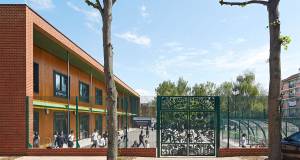 East London passive school promotes active learning
East London passive school promotes active learning -
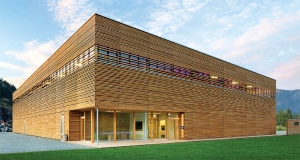 International selection - issue 11
International selection - issue 11 -
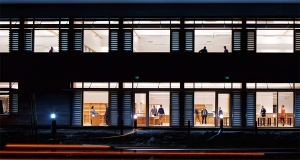 Hereford archive chooses passive preservation
Hereford archive chooses passive preservation -
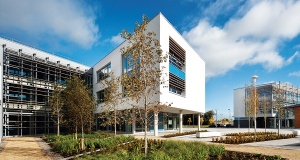 Low energy Tipperary offices go for gold
Low energy Tipperary offices go for gold -
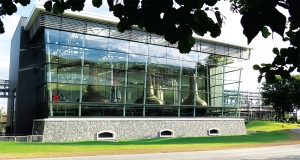 Irish whiskey distillery puts fabric first
Irish whiskey distillery puts fabric first -
Opinion
-
Thermal bridging
-
Isover awards
-
Carlow A1 upgrade

